The following is an excerpt from Harold Davis’s Composition & Photography
“If you look at any walls spotted with various stains or with a mixture of different kinds of stones, if you are about to invent some scene you will be able to see in it a resemblance to various different landscapes adorned with mountains, rivers, rocks, trees, plains, wide valleys, and various groups of hills. You will also be able to see divers combats and figures in quick movement, and strange expressions of faces, and outlandish costumes, and an infinite number of things which you can then reduce into separate and well conceived forms.” —Leonardo da Vinci
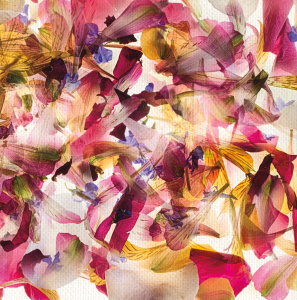
If Jackson Pollock Dripped Using Flower Petals—Jackson Pollock was my inspiration when I made this image. I stood near my light box with piles of different flower petals. Saying a prayer to the gods of Zen serenity, serendipity, and simultaneously embracing chaos, I started tossing petals onto the light box. I tried to retain randomness while embracing an underlying cohesive pattern in how I tossed the petals.
Nikon D850, 55mm Zeiss Otus, seven exposures with shutter speeds ranging from 1/8 of a second to 4 seconds, each exposure at f/16 and ISO 64, tripod mounted.
In nineteenth-century France and elsewhere, the rigors of academic painting softened to the more-forgiving-of-reality Impressionism. This was partly due to the invention of photography: what was the point of all that rigor if a camera could render “reality” more simply?
As time went by, and the bonds that tied art to realism further loosened, Impressionism morphed into more free-form, two-dimensional art movements, including Fauvism, Cubism, and Surrealism. Eventually, by the 1950s in New York City, Abstract Expressionism was the dominant mode in the art world, and the already tenuous connection between art and “reality” had frayed well beyond the breaking point.
To abstract literally means to take something out of something else. In science, an “abstract” is a synopsis-in-brief of the results of an experiment or a scientific theory. In art, to abstract means to change a literal subject to something more symbolic. This kind of abstraction exists on a spectrum, with abstract art that has almost no visual connection to the literal real world.
Photography has always had a more fraught relationship with abstraction than other forms of art. This is because a photograph is often taken to be a literally truthful rendition of reality. But as I explained earlier (see page 160), it is simply not logically possible to create a two-dimensional version of our three-dimensional reality.
Despite the ambiguous and ambivalent connection of the camera to reality, it has long been recognized—at least since the well-known 1951 Museum of Modern Art exhibition Abstraction in Photography—that photographs can be abstractions. Photographs work as abstractions both in the sense of abstracting and loosening reality, and also further along the spectrum as a tool and source material for the creation of fully abstract, non-literal art.
These possibilities provide powerful compositional fodder for the creative photographer.
Along the Abstraction Spectrum
From the very beginning, photography—despite its association with a literal rendition of the world—was clearly regarded as a medium for abstraction. This is clear, if nowhere else, in the very name photography, which translates to “drawing with light” or “writing with light.” Drawing generally is, itself, a process of abstraction. Writing is by its very nature a symbolic process of abstraction. Adding light to the mix merely reinforces the sense that something involving magical transformation is involved, and that the process is not just literal.
When the photographic subject is abstracted, but to some extent literal, meaning that portions of the image can be realized but the image is presented in a poetic or metaphorical kind of way, the process is relying on two related phenomena: pareidolia and anthropomorphism.
Pareidolia refers to the human propensity for assigning meaning to an apparently random or ambiguous visual pattern—for example, when someone sees shapes in the clouds, or looks at patterns of sand on the beach and sees a mountain range, as in Mountains on the Beach, below.
Personally, I sometimes think of the pareidolia phenomenon in terms of the swaggering Captain Jack Aubrey character in Patrick O’Brian’s classic Aubrey-Maturin sea stories set during the Napoleonic Wars. In these books, Aubrey often gets away with feats of cloaked derring-do, slipping by without being observed because people “only see what they expect to see.”

Mountains on the Beach—Standing on a bluff in the howling, gale-force wind high above the great beach at Point Reyes National Seashore, California, I took this photograph of the patterns in the sand left behind by wind and waves.
You can get a sense of the scale of the original scene by looking at the human footprints wandering through the upper left of the image, and the surf at the bottom. The result is an abstraction of the literal sand on the beach into a landscape reminiscent of paintings of Chinese mountains.
Nikon D200, 18-200mm Nikkor zoom at 170mm, 1/200 of a second at f/7.1 and ISO 100, hand held.
Anthropomorphism is the human tendency to translate shapes into human, and by extension animal, form. For example, when someone looks up at a cloud in the sky and says, “I see a whale!” this is anthropomorphism (actually, “animalmorphism,” but let’s not quibble!).
Both pareidolia and anthropomorphism are related to the idea behind the Rorschach test. The Rorschach test uses apparently abstract art as a projective device where the subject picks out supposed meanings based on patterns and anthropomorphisms. Trained psychologists can then, supposedly, derive insights about the test subject.
So along the more reality-based end of the abstraction spectrum, the artist is rendering a real object. That object can be stylized, distorted, or exaggerated, using colors and textures to communicate emotions and feelings, rather than with the goal of producing a replica. As an example, consider the Russian artist Wassily Kandinsky, a founder of Abstraction, and the author of On the Spiritual in Art, written in 1911 and one of the most influential theoretical books on abstract art. Kandinsky was born with synaesthesia—a rare condition that for him translated sounds into colors. He believed that his paintings used different shades of color to provoke a range of sounds and emotions, and to touch the portions of the brain connected with music.
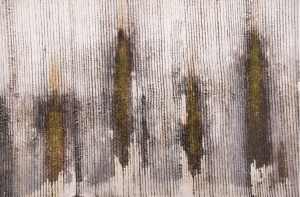
Garden Wall, Nara—Wandering in the gardens of the old imperial city of Nara, Japan, I looked away from the cultivated plantings, and noticed that one garden wall had seeps and stains from lichen. I carefully framed the image to create an abstraction.
One of my goals when I made this composition was to be careful to capture a recognizable pattern as part of the image. The green bars alternate short and long, and the whole creates a pleasing sense of balance without being so symmetrical that the viewer’s eye skims over the image without being engaged.
Nikon D800, 28-300mm Nikkor zoom at 135mm, 1/125 of a second at f/9 and ISO 400, hand held.
Heading further along the abstraction spectrum, abstract art gets even more abstract, meaning it goes well beyond any representation of “the facts.” Abstract art attempts to build a new self contained reality. In the case of a photograph, this reality is on a two-dimensional plane. One point of view is that abstract art on a two-dimensional plane should be created by pure patterns of form, color, and line. This is a line of aesthetics that goes back at least as far as Plato.
The Platonic ideal of beauty consists of an arrangement of integral parts into a coherent whole, according to order, proportion, and symmetry. In this world view, the main purpose of abstraction in art is not to tell a story, but to encourage involvement and imagination.
Abstraction goes back a long way, perhaps to the birth of humanity. The Paleolithic cave paintings in Lascaux—from more than 15,000 years ago— contain abstractions.
Even once you grant that the purpose of a photograph is to create a symbolic generalization, there remains the question of whether this should be done following neat, ordered, and structured patterns, or as a matter of emotional gesture. Abstract Expressionism has room for both the order of a Mark Rothko color-field painting and the drippings of a Jackson Pollack.
Certainly, a completely abstract work of art—at the far end of the abstraction spectrum—can convey emotion. For example, Mark Rothko’s black paintings in the Rothko Chapel in Houston, Texas, are deeply moving. And as the 1986 Los Angeles County Museum of Art landmark exhibition The Spiritual in Art: Abstract Painting 1890–1985 amply demonstrated, a common goal in abstract art is the conveyance of emotion and the ineffable in the universe.
The only question remaining is whether photography is an art that is capable of participating in the ability to abstract that is the birthright of all other two-dimensional art forms. In this, there can be no real doubt. Photography’s ability to render literal scenes can make it easier for people to forget its power of abstraction. This is an issue of opening one’s eyes and grasping the myriad tools and techniques that are available.
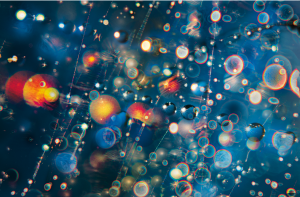
At Home in the Universe—My favorite time to photograph water drops is on a sunny morning when it has rained overnight. That way, you get the drops as on the spiderweb here, and you also get to play with reflected, refracted, and diffracted sunlight.
To create this abstraction, I used a macro lens to shoot twenty-one exposures of a spiderweb in the earlymorning sun. Since the exposures were hand held, they varied in terms of what they captured, but I tried to keep my lens consistently pointed toward the center of the web. The bulk of the exposures were underexposed to bring out color saturation and to allow the background to go dark. In post-production, I combined the various captures using stacking.
While parts of this image can be read literally—the water drops that start in the middle and move in a line to the right are an example—the nature of this abstraction is that it could be many different things: a scene in outer space, a deep-sea environment, strands of DNA, or whatever the imagination says it is.
Nikon D300, 105mm Nikkor macro, twenty-one exposures, most exposures at 1/3200 of a second at f/3.5 and ISO 200, hand held.
Key Ideas for Abstraction
Your eyes, and your ability to previsualize, are your best tools for creating photographic abstractions. The trick here is to train yourself to see photographic subjects as a potential basis for an abstraction. Does that rock look like a bear? Would there be a possibility for an interesting image if you collaged certain things together?
There’s no end of possibilities. But it all has to start with your personal vision. This can be learned and can be trained.
Start by slowing down. Be sure to always look around you. If you are someplace special, don’t settle for the obvious. What else is there to see? Turn your camera away from the Taj Mahal or the Eiffel Tower or the majesty of a waterfall in Yosemite and see what is behind you, or above you, or below you. Remember, the best camera to use is the one you have with you, and photographic vision is almost never about gear.
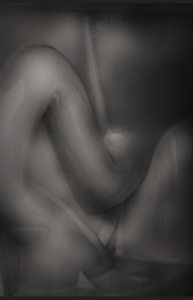
Porcelain Series No. 1—At a local salvage yard, I got low to the ground with my camera on a tripod to photograph beneath a plumbing fixture, and pointed the camera up at the underside of the porcelain. The result is this largely abstract image where the subject matter is not obvious at first glance.
Nikon D300, 85mm Nikkor macro, 1/15 of a second at an adjusted aperture of f/64 and ISO 100, tripod mounted.
With that in mind, here are some of the most important tools and techniques for creating abstract, rather than literal, photographic images:
Macros—Often closeups, the more extreme the better, present a view of the world that one has never seen before. Many of these new vistas are at least partly abstract, and it can be hard for the viewer to recognize the literal subject matter.
Camera angles—It’s astounding how shifts in your camera’s position and point of view can change things and create abstractions. Sometimes all it takes is getting down on the ground and photographing from far below— for an example, take a look at Porcelain Series No. 1.
Changing orientation—There’s nothing set in stone about the orientation of your images. A horizontal can be shifted to the vertical, or vice versa, or even at some angle in between. You can change this orientation in your camera, or change it in post-production. For example, Mountains on the Beach was rotated 90 degrees in post-production.
In-camera techniques—There are a variety of techniques you can use in your camera to create abstractions. Some of these are: in-camera motion (ICM), used to create Bus Window 1 on page 96; in-camera multiple exposures used to make Devotion on page 141; and something as simple as a long exposure to abstract waves, clouds, and other moving subjects, as in Cayucos Pier on pages 142–143.
Alternative processing—In the wet darkroom, alternative tools included solarization, cross-processing, and other chemical interventions were used experimentally. Most of these filmera techniques can be simulated digitally. In addition, there are some alternative processing techniques that belong solely to the digital realm. A good example is the use of LAB color; as an example, take a look at Colored Apple Slices on pages 52–53.
Alternative spectrums—Digital captures can be made using light waves in spectra that are not normally visible to the human eye, or for that matter, to the camera. For example, Infrared (IR) and Gamma rays can both be recorded using appropriate gear. IR and Gamma rays are not part of the visible light spectrum. Gamma rays are used in x-ray imaging. As an example of an image that used x-ray capture, check out Sunflower X-Ray Fusion on page 235.
Collaging—Collages can be created literally by cutting and pasting pieces of paper or other substrate together. An example is David Hockney’s use of small Polaroid photographs to create alternative perspectives and avoid the one-eyed “paralysed Cyclops” of photography (see page 159).
Collages can also be created virtually. Much of my work involves virtual collaging using postproduction— for example, Down the Rabbit Hole on page 158. It has been said that in addition to being a photographer, I am an artist that uses my photographs as the source material for my virtual collages. Pro tip: If you think you may be interested in virtual collaging, when you are in the field on location, take every angle, point of view, and closeup, even if you don’t know for sure that you will end up using it. It’s hard to go back and photograph this kind of thing again, and frustrating to find you’re missing something important when you begin the virtual collaging process in post-production.
There are many other techniques for creating photographic abstractions. The ones I have listed here are a good starting place, and you will find many examples of their use throughout Composition & Photography.
It all comes down to seeing. Enjoy the process of looking around you and observing. Furthermore, try to practice seeing the world with “beginner’s” eyes. This is a reference to the Zen term “beginner’s mind”: the idea that if you start without preconceptions, you will see and find more in your practice in the everyday world that surrounds you with so many possibilities and such interest and joy.
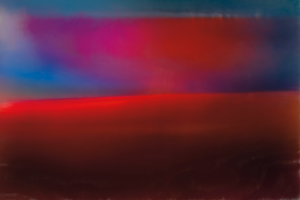
Homage to Rothko—Mark Rothko was an Abstract Expressionist painter, best known for his canvases with regions of vibrant color, abstracted into rectilinear shapes.
With Rothko in mind, I created this abstract image by adding food color to water, with the colored water placed in a glass vase. I photographed sunlight coming through the water, using a wide-open aperture (f/1.6). To complete the image, I rotated it 90 degrees in postproduction, and added a slight canvas effect.
Nikon D850, 85mm Lensbaby Velvet, 1/500 of a second at f/1.6 and ISO 64, hand held.
